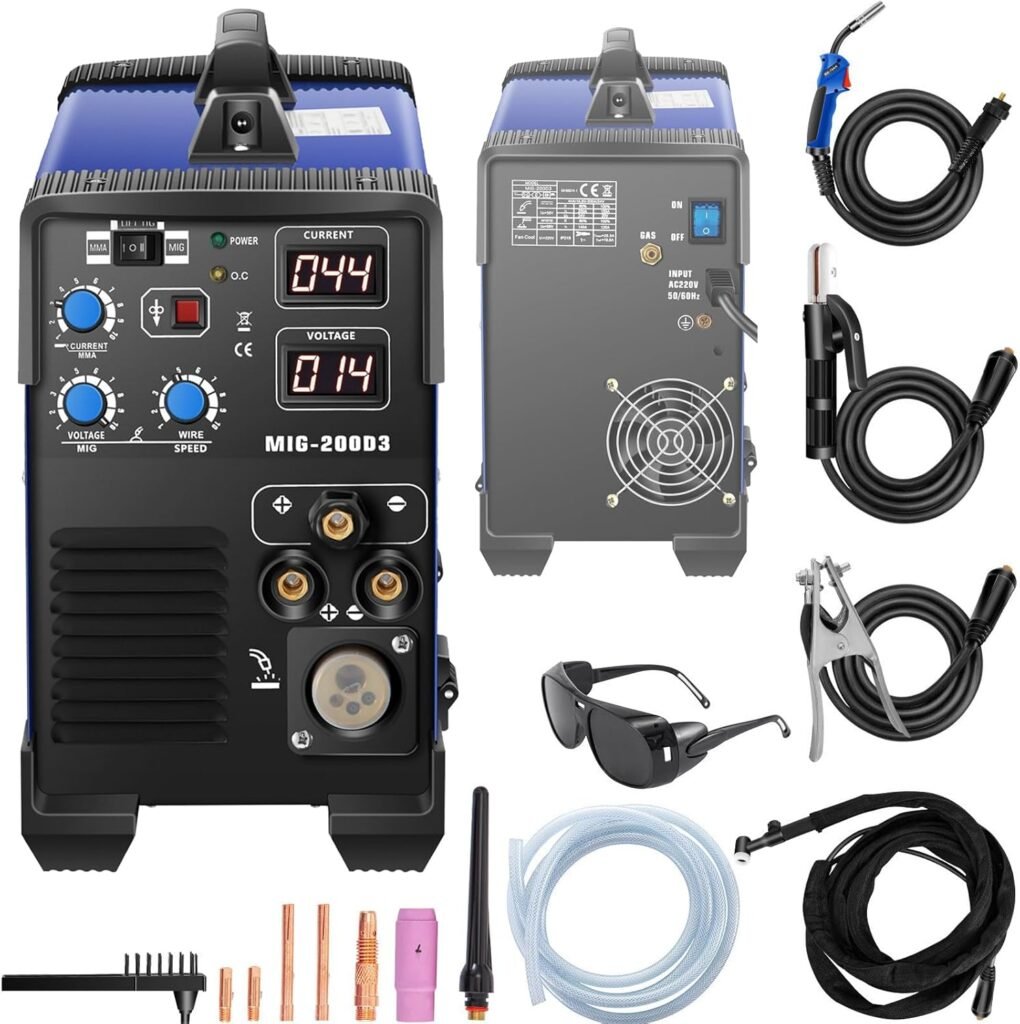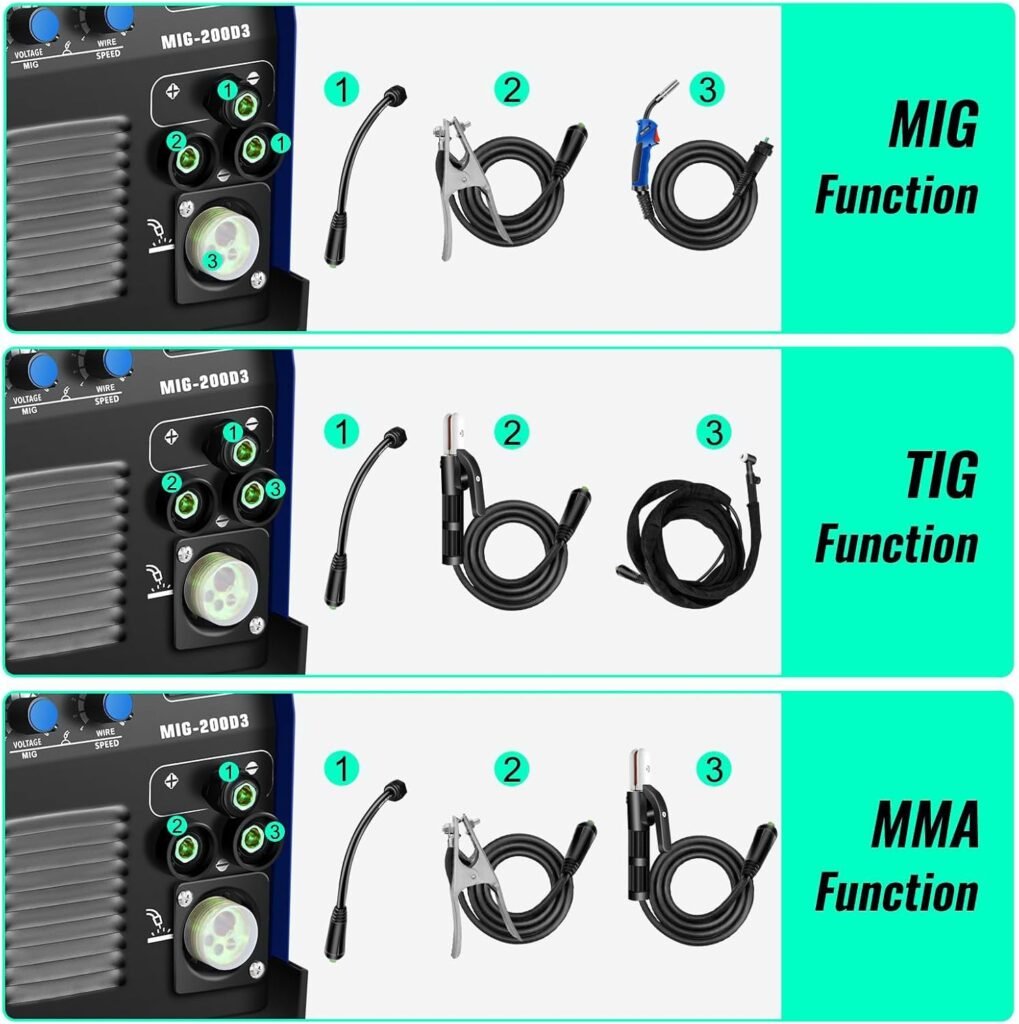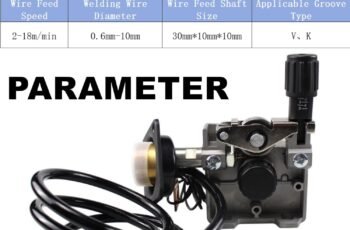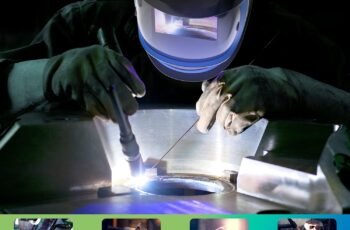Ad Blocker Detected
Our website is made possible by displaying online advertisements to our visitors. Please consider supporting us by disabling your ad blocker.
? Looking for a compact, cost-effective welder that can handle MIG, MMA (stick), and Lift TIG for everything from simple repairs to light fabrication?
Product Overview
You’re looking at the 3 In 1 Combo Inverter Welder, Inverter Portable Welder with Digital On-screen Display, MMA/MIG/LIFT 3 In 1 Combo, for Steel and Iron Aluminum Repairing Easy To Use for Beginners and Professionals. This unit combines three welding processes in one portable package, designed to be easy to carry and simple to operate. It aims to give you enough flexibility to work on carbon steel, iron, stainless steel, and many basic aluminum repairs without needing multiple machines.
What the package promises
The manufacturer positions this as an all-in-one solution for both novice and experienced users. It highlights IGBT inverter technology for arc stability, a digital on-screen display for easier parameter control, and compatibility with common wire sizes and spool formats.
Key Features
Under this heading you’ll find the headline specs and practical features that matter when choosing a combo welder. Each feature influences what you can weld and how comfortable the machine is to use.
| Feature | Details | Why it matters |
|---|---|---|
| Welding Modes | MIG, MMA (stick), Lift TIG | Gives you flexibility to pick the best process for the job and metal condition |
| Inverter Type | IGBT inverter technology | More efficient, stable arc, lighter weight than old transformer units |
| Wire Compatibility | 0.024″, 0.031″, 0.039″ (flux cored and solid), supports 2.2 lb and 11 lb spools | Lets you use common flux-cored wires for gasless welding and larger spools for longer runs |
| Digital Display | On-screen display of settings | Easier to set and repeat parameters, reduces guesswork |
| Protection | Overheat and overload protection, IP21 splash resistance | Protects the machine and improves safety and lifespan |
| Weight | 18.5 pounds | Very portable — easy to carry to job sites or around a garage |
| Target Metals | Carbon steel, iron, stainless steel, aluminum (basic repairs) | Useful for a wide range of home, farm, and auto repairs |
Design and Build Quality
The machine is compact and lightweight, making it practical for transport and storage. Build quality reflects its price point: the case and handle are convenient for occasional to regular use, while internal cooling and protection features are there to prevent premature failure during normal jobs.
Portability and Ergonomics
You can carry this welder with one hand comfortably; it weighs about 18.5 pounds and has a built-in handle that helps you move it around. That portability is especially helpful if you work outdoors or need to take the unit to different locations for maintenance tasks.
Welding Modes and Performance
This unit supports MIG, MMA (stick), and TIG Lift modes. Each mode has strengths and limits, so you’ll pick the best one depending on the metal, surface condition, and whether you have shielding gas available.
MIG Mode
MIG is ideal for faster material deposition and for projects where you want cleaner beads with less slag. The machine accepts flux-cored wire sizes 0.024″, 0.031″, and 0.039″, and can also be set up for solid wire — but remember that solid wire typically requires a shielding gas to get clean MIG welds. The unit allows you to control wire feed speed, which is essential to match the welding current and arc characteristics.
MMA (Stick) Mode
MMA or stick welding is forgiving on dirty, rusty, or painted surfaces and is great for general repair work. You’ll appreciate how stick mode works well outdoors and on thicker, rougher parts without needing shielding gas. The combination of inverter technology and stick mode aims to give more arc stability and easier starts compared to older transformer stick machines.
TIG (Lift) Mode
The Lift TIG mode is a touch-start TIG method where you briefly touch the tungsten to the workpiece and lift to start the arc. This method is simpler than high-frequency starts and reduces interference with electronics. TIG welding still requires a TIG torch, appropriate tungsten, and shielding gas for quality stainless or aluminum TIG welds, so plan to add accessories if you’ll TIG often.
IGBT Inverter Technology
The machine uses IGBT (Insulated Gate Bipolar Transistor) inverter technology, which gives you a more stable arc, better energy efficiency, and a lighter weight profile compared to older designs. This tech also tends to provide better current control, giving smoother starts and less spatter in many instances.
Why arc stability matters
A stable arc reduces spatter, makes bead formation easier, and lowers the amount of cleanup you’ll need to do. Stable current output also means more predictable results when you adjust parameters like wire feed speed, current, and voltage.
Wire and Consumables Compatibility
The welder accepts 0.024″, 0.031″, and 0.039″ wires — both flux-cored (which can be run gasless) and solid wire (which generally requires shielding gas). It can handle small 2.2 lb spools and larger 11 lb spools, giving you options for short projects or longer continuous runs.
Choosing wire and gas
If you want gasless MIG (flux-cored), you can weld outdoors or in drafty areas without a gas bottle. For cleaner MIG or for TIG, you’ll need shielding gas — typically a CO2/argon mix for MIG on steel and pure argon for TIG. For aluminum MIG work, you’ll often need a spool gun or specialized feed setup to prevent bird-nesting.
Safety Features
Safety is built into the unit with automatic overheating and overload protection, which shuts the machine down if it gets too hot or is overloaded. It also has an IP21 rating for splash resistance, which helps protect components from light moisture and welding spatter — but doesn’t replace safe operating procedures.
Recommended PPE and shop setup
Even with protective features, you should always use a welding helmet with the right shade, welding gloves, long sleeves, and eye protection for grinding. Make sure you have ventilation or local exhaust when welding indoors to avoid fumes, and keep a fire extinguisher nearby.
Setup and First Use
Setting it up is straightforward, but you’ll need to follow a few basic steps to get consistent results. Unbox carefully, check included leads and torches, attach the ground clamp to clean metal, load the correct wire, and configure welding mode and parameters on the digital display.
Step-by-step starter checklist
- Inspect cables, torch, and connectors before plugging in.
- Attach ground clamp to a clean, unpainted surface near the weld area.
- Load the correct wire type and spool size and set the wire feed tension.
- Select MIG, MMA, or TIG Lift on the digital display.
- Adjust wire feed speed (MIG) or current (MMA/TIG) and test on scrap metal.
- Tweak settings until you have a steady arc and acceptable bead profile.
Practical Tips for Beginners
You’ll get better results faster by practicing on scrap metal before jumping into a real project. Start with flux-cored MIG or stick welding if you don’t want to handle gas setups, and practice maintaining consistent travel speed and electrode angle.
Simple learning progression
Begin with flux-cored MIG on clean sheet metal, then try stick welding on thicker plates, and only move to TIG when you’re comfortable with arc control and have the right accessories. Use the digital display to write down successful settings so you can repeat them.
Advanced Tips for Professionals
If you’re experienced, you’ll appreciate the convenience of a lightweight, multi-process unit for quick fixes and on-site jobs. Use proper shielding gas mixes, higher-quality tungsten and filler rods when TIG welding, and consider adding a spool gun for consistent aluminum MIG results.
Fine-tuning for better results
Small changes in wire feed speed, travel angle, and torch distance can dramatically affect bead quality. Carry spare consumables like tips and nozzles and check cable connections regularly to prevent voltage drop and inconsistent arc behavior.
Performance on Different Metals
This machine is designed to weld carbon steel, iron, stainless steel, and basic aluminum repairs. It handles standard repair and maintenance tasks well; however, complex or heavy aluminum work often demands dedicated equipment (spool gun, separate TIG setup with pedal) for the best results.
Aluminum considerations
Aluminum has different thermal properties and needs better wire feeding to avoid snags. For thin aluminum or small repairs you might get by with careful MIG technique and proper flux-cored or aluminum wire, but for professional aluminum fabrication, a spool gun or specialized MIG feeder is recommended.
Typical Use Cases and Projects
Think of this unit as a generalist for home, farm, and light professional tasks. You can patch rusted panels, repair farm equipment, build small frames, do light auto-body work, and handle general maintenance.
Example projects
- Repairing a rust hole in a trailer tongue using flux-cored MIG and backing plate.
- Rebuilding a mower deck bracket with stick welding for thicker sections.
- Touch-up TIG welds on stainless clamps with a proper gas setup.
- Temporary aluminum repair on a non-structural item (with care and correct filler material).
Maintenance and Care
Keep the machine dry and clean, inspect cables and connectors regularly, and clean the wire feed path to prevent feeding issues. Replace consumables like contact tips and nozzles when worn, and ensure vents are clear to keep cooling effective.
Storage and long-term care
Store the unit in a dry, dust-free place and disconnect cables if it won’t be used for long periods. Regularly check the fan and internal filters (if present), and don’t drop or abuse the torch leads and connectors.
Troubleshooting Common Issues
When things go wrong, a few common fixes cover most problems: check ground connections, ensure wire is loaded correctly, confirm correct polarity for MIG, and make sure the right gas flow and gas type are selected when required.
Quick fixes for common symptoms
- Intermittent arc or poor wire feed: check feed tension, spool alignment, and liner cleanliness.
- Excessive spatter: reduce wire feed speed or adjust voltage, check for dirty metal.
- Machine overheating/automatic shut-off: allow it to cool, reduce duty cycle or welding intensity, confirm proper ventilation.
- TIG arc not starting: check tungsten, ground, and gas flow; ensure proper Lift-TIG procedure.
Pros and Cons
This section summarizes the practical advantages and limitations so you can decide if the machine fits your needs.
| Pros | Cons |
|---|---|
| Very portable and lightweight | May lack the sustained duty cycle for heavy production work |
| Three welding processes in one unit | For best TIG and aluminum results, you may need extra accessories |
| Digital display simplifies setup | Not a replacement for high-end dedicated TIG/MIG machines |
| Uses common wire sizes and spool formats | Flux-cored MIG is more convenient but produces slag and less clean welds |
| Built-in safety protections | IP21 is not full waterproofing — avoid wet conditions |
Accessories You Should Consider
To get the most out of the unit you’ll want a few extras: a good-quality welding helmet, a variety of contact tips and nozzles, a spool gun or improved feeder for aluminum, argon and argon/CO2 gas bottles and regulators, and TIG torch and tungsten if you plan to TIG frequently.
Consumable checklist
- Flux-cored wire in the sizes provided for gasless MIG.
- Solid wire and a shielding gas kit if you want clean MIG.
- Tungsten electrodes and a TIG torch for Lift TIG work.
- Replacement contact tips, nozzles, and drive rollers.
- A good chipping hammer and wire brush for cleanup.
How This Machine Compares to Dedicated Machines
A multi-process combo provides versatility, but dedicated machines will outperform combos in high-volume or highly specialized tasks. If you need precise TIG for thin stainless or high-volume industrial MIG production, a dedicated machine is preferable. For generalist needs, repairs, and occasional professional work, the combo offers great value.
Value proposition
You get three processes for the price of a single compact unit. That’s excellent for people who need flexibility, travel between sites, or don’t want to own multiple machines. Pros who need full-time, high-duty-cycle performance on one process might still prefer dedicated equipment.
Buying Considerations and Warnings
Before buying, check the duty cycle and rated output in the technical specifications (not always provided with basic listings). Verify what accessories are included — spools, torches, and leads vary by package. Also confirm the warranty and after-sales support available from the seller or manufacturer.
Safety and legal reminders
Always follow local electrical codes and use appropriate grounding means. Use gas cylinders and regulators that meet safety standards, and keep combustible materials away from your welding area.
Troubleshooting Deep Dive
If you’re comfortable with a deeper troubleshooting approach, check wire feed liners for kinks, ensure proper polarity for MIG (some flux-cored wires prefer DC-), and inspect the internal connections for any loose screws or burnt contacts. Calibration of the wire feed speed vs. displayed values may be necessary on first use.
When to seek professional service
If the unit trips internal protection frequently despite normal loads, or you smell burning inside components, stop and consult service. Internal electronics faults or fan failures can cause further damage if ignored.
Warranty, Support, and Parts Availability
Warranty coverage and parts availability vary by seller. You should confirm the length and terms of the warranty, and ask about replacement parts such as torches, PCBs, and fans. Having access to customer service and spare parts increases the long-term value of your purchase.
How to document issues for claims
Take clear photos of the unit, serial number, and any wiring, and record the conditions under which a fault occurred. This helps speed the claims process if you require repair or replacement under warranty.
Final Verdict
If you want a portable, versatile welding machine that handles MIG, MMA, and Lift TIG for general repairs and light fabrication, the 3 In 1 Combo Inverter Welder, Inverter Portable Welder with Digital On-screen Display, MMA/MIG/LIFT 3 In 1 Combo, for Steel and Iron Aluminum Repairing Easy To Use for Beginners and Professionals is a strong candidate. It’s lightweight, uses IGBT inverter tech for better arc control, and supports common wire sizes and spool formats.
Who should buy it
Buy this unit if you need flexibility and portability, you work on a variety of metals for maintenance or hobby fabrication, or you’re learning multiple welding processes and want one machine to practice on. Consider a dedicated MIG or TIG machine if you focus heavily on high-quality TIG aluminum or high-production MIG work.
Final Tips to Get the Most from Your Purchase
Keep a small practice kit of scrap metal to test settings, label and save successful parameter combinations on the digital display, and invest in quality consumables and PPE. With proper setup and a bit of practice, you can make this compact 3-in-1 welder a reliable and useful tool for many tasks.
If you want, tell me the types of projects you plan to do and the metals and thicknesses you’ll work with, and I’ll help you pick consumables and recommend starting settings you can try.
Disclosure: As an Amazon Associate, I earn from qualifying purchases.







